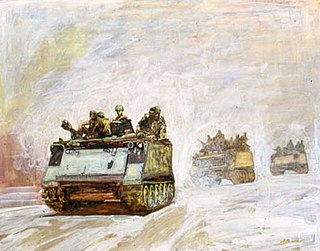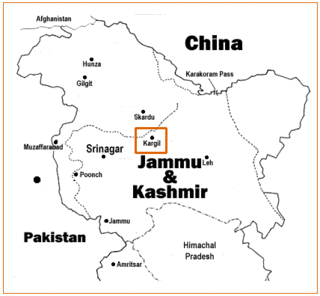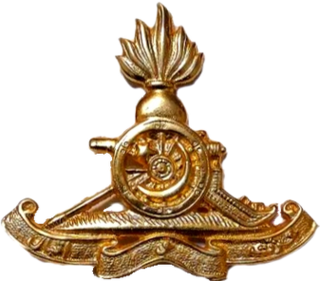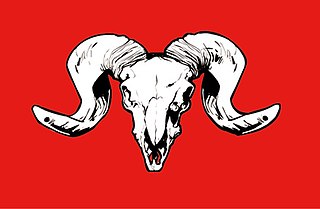
Self-propelled artillery is artillery equipped with its own propulsion system to move toward its firing position. Within the terminology are the self-propelled gun, self-propelled howitzer, self-propelled mortar, and rocket artillery. They are high mobility vehicles, usually based on continuous tracks carrying either a large field gun, howitzer, mortar, or some form of rocket/missile launcher. They are usually used for long-range indirect bombardment support on the battlefield.

The Royal Australian Armoured Corps (RAAC) is an administrative corps of the Australian Army. It provides the Australian Defence Force's Armour capability, which performs the function of mounted combat. Armour combines firepower, mobility, protection and networked situational awareness to generate shock action and overmatch in close combat. Armour is an essential element of the combined arms approach that is employed by the Australian Army.

Armoured cavalry are combat units using armoured fighting vehicles (AFVs) instead of horses. They began to replace horse cavalry in the heavy shock and the light reconnaissance, skirmishing and exploitation/pursuit roles in most armies commencing after the First World War.

The 2nd Division is one of nine active divisions of the Japan Ground Self-Defense Force. The division is subordinated to the Northern Army and is headquartered at Camp Asahikawa in Asahikawa, Hokkaidō. Its responsibility is the defense of North Western Hokkaidō.

The Serbian Army is the land-based and the largest component of the Serbian Armed Forces.
3rd Regiment Royal Horse Artillery is a regiment of the Royal Horse Artillery in the British Army. They are currently based at Albemarle Barracks, Northumberland, England.
1st Regiment Royal Horse Artillery is a regiment of the Royal Horse Artillery in the British Army. It currently serves in the armoured field artillery role, and is equipped with the AS90 self-propelled gun. The regiment is currently based at Larkhill Garrison, Larkhill. The regiment completed its move from Assaye Barracks, Tidworth, to Larkhill in June 2019.
List of abbreviations, acronyms and initials related to military subjects such as modern armour, artillery, infantry, and weapons, along with their definitions.

The Kargil War order of battle (KWORBAT), is a deposition and systematic combatant structure of the Indian Army troops and the unified Pakistan Armed Forces combat commands, active in the Kargil region in 1999, during the Kargil War. The Indian Army orbat is based on the publications provided by the Indian military authors, news media and official sources.

The Regiment of Artillery is a combat/fighting arm of the Indian Army, which provides massive firepower during all ground operations of the Indian Army. It is a successor to the Royal Indian Artillery (RIA) of British Indian Army, which itself traces its origins to the formation of Bombay Artillery in 1827.

The Cavalry Brigade "Pozzuolo del Friuli" is a brigade of the Italian Army, based in the Friuli Venezia Giulia and Veneto regions. The Brigade consists of a command unit, a cavalry regiment, an amphibious infantry regiment, an artillery regiment, an engineer regiment and a logistic regiment.

The Airmobile Brigade "Friuli" is an airmobile brigade of the Italian Army, based mainly in the Emilia-Romagna region. The brigade was part of the 1st Defence Forces Command until it was transferred to the Division "Friuli". The brigade's coat of arms depicts a stylized version of the Rocca di Monfalcone castle near the city of Monfalcone in the Friuli region, where the brigade distinguished itself during World War I. Since 1 July 2019 the brigade is part of the Division "Vittorio Veneto".

The Regiment of Artillery is the artillery regiment of the Pakistan Army tasked with operating field artillery including muzzle-projectile weapons. Despite the name, the Regiment is itself composed of a number of battalion-sized regiments, most of which are operationally deployed as part of Army corps and divisions.
The Northern Army Group (NORTHAG) was a NATO military formation comprising five Army Corps from five NATO member nations. During the Cold War NORTHAG was NATO's forward defence in the Northern half of the Federal Republic of Germany (FRG). The Southern half of the Federal Republic of Germany was to be defended by the four Army Corps of NATO's Central Army Group (CENTAG). During wartime NORTHAG would command four frontline corps and one reserve corps. Air support was provided by Second Allied Tactical Air Force.

After World War II the Italian Army had two units named "Centauro": from 1952 to 1986 the Armored Division "Centauro" and from 1986 to 2002 the Armored Brigade "Centauro". Both units were successor to the World War II era 131st Armored Division "Centauro". The units' name came from the mythological race of half human-half horse creatures named Centaurs.

The 1st Artillery Brigade was a support formation of the British Army from 1961-77 and from 1997. Part of the 3rd Division, it oversaw all army close support artillery and deep fires units. Under the Future Soldier programme, the brigade merged with 1st Armoured Infantry Brigade to form 1st Deep Reconnaissance Strike Brigade Combat Team.
The full structure of the Polish Land Forces is:
The following is a hierarchical outline for the Italian Army at the end of the Cold War. It is intended to convey the connections and relationships between units and formations.
With the 1975 reforms the Italian Army abolished the regimental level and replaced it with brigades made up of multiple arms. During the reform the army disbanded 48 regimental commands and reduced its force by 87 battalions. A further ten regimental commands were used to raise ten new brigade commands. Ten training centers, which for traditional reasons had carried the names of regiments, were also disbanded. The reduction in units also allowed to mechanize most of the remaining units in Northern Italy and Italy's defense strategy changed from a hold-at-all-costs territorial defense to one of mobile warfare.













